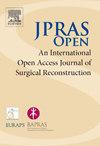激光连续多普勒血流法监测自由皮瓣的未来:对连续71例患者的前瞻性评估。
IF 1.5
Q3 SURGERY
引用次数: 0
摘要
目的:评价激光多普勒血流仪(LDF)检测微血管游离组织移植过程中灌注紊乱的有效性。方法:该前瞻性研究于2020年12月至2022年9月在单中心进行,涉及71例主要接受头颈部游离皮瓣重建的患者,使用Pocket LDF™进行连续灌注监测。结果:71例患者中,剔除明显噪声或传感器脱离者,对69例患者的数据进行分析。9例(13.0%)出现血流障碍,其中5例在同一区域有手术或放疗史。缺血5例,其中4例发生在监测期间。静脉充血4例,其中1例发生在监测过程中。再次手术8例(11.6%),包括皮瓣置换术、血管吻合术和血肿清除术。皮瓣完全坏死5例(7.2%),部分坏死3例(4.3%)。LDF装置能够在临床症状出现前数小时识别灌注问题,这表明其具有早期干预的潜力。然而,挑战包括在手术后和患者转移期间立即保持持续监测。结论:LDF是一种有价值的、无创的自由皮瓣手术中灌注障碍早期检测工具。它提供持续的、实时的微循环反馈,促进及时干预。尽管它有很多好处,但要提高监测的可靠性,还需要增强传感器的附着力和无线技术。建议进一步研究以完善LDF的使用并验证其在各种临床环境中的有效性。本文章由计算机程序翻译,如有差异,请以英文原文为准。
The future of free flap monitoring by laser continuous doppler flowmetry: A prospective assessment in consecutive 71 patients
Objective
This study evaluated the effectiveness of laser Doppler flowmetry (LDF) in detecting perfusion disturbances during microvascular free tissue transfer.
Methods
Conducted at a single centre from December 2020 to September 2022, this prospective study involved 71 patients mainly undergoing head and neck free flap reconstructions, using the Pocket LDF™ for continuous perfusion monitoring.
Results
Out of the 71 cases, data from 69 cases were analysed after excluding those with significant noise or sensor detachment. Blood flow disturbances were observed in 9 cases (13.0 %), with 5 of these cases with a history of surgery or radiation in the same area. There were 5 cases of ischaemia, 4 of which occurred during monitoring. There were 4 cases of venous congestion, with 1 occurring during monitoring. Re-operation was necessary in 8 cases (11.6 %), involving flap replacements, vascular re-anastomoses and hematoma evacuation. Complete flap necrosis occurred in 5 cases (7.2 %) and partial necrosis occurred in 3 cases (4.3 %). The LDF device demonstrated the ability to identify perfusion issues hours before the clinical symptoms manifested, suggesting its potential for early intervention. However, challenges included maintaining continuous monitoring immediately post-surgery and during patient transfers.
Conclusion
LDF is a valuable, non-invasive tool for early detection of perfusion disturbances in free flap procedures. It provides continuous, real-time feedback on microcirculation, facilitating timely interventions. Despite its benefits, enhancements in sensor adhesion and wireless technology are needed to improve monitoring reliability. Further studies are recommended to refine LDF usage and validate its efficacy in various clinical settings.
求助全文
通过发布文献求助,成功后即可免费获取论文全文。
去求助
来源期刊

JPRAS Open
Medicine-Surgery
CiteScore
1.60
自引率
0.00%
发文量
89
审稿时长
22 weeks
期刊介绍:
JPRAS Open is an international, open access journal dedicated to publishing case reports, short communications, and full-length articles. JPRAS Open will provide the most current source of information and references in plastic, reconstructive & aesthetic surgery. The Journal is based on the continued need to improve surgical care by providing highlights in general reconstructive surgery; cleft lip, palate and craniofacial surgery; head and neck surgery; skin cancer; breast surgery; hand surgery; lower limb trauma; burns; and aesthetic surgery. The Journal will provide authors with fast publication times.
 求助内容:
求助内容: 应助结果提醒方式:
应助结果提醒方式:


